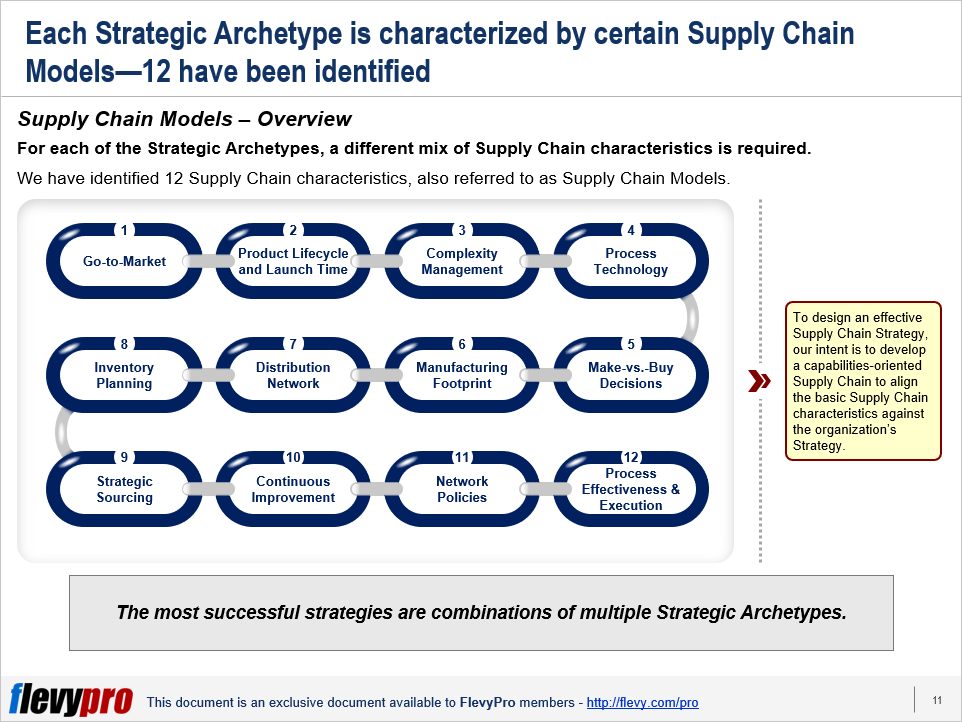Editor's Note: Take a look at our featured best practice, AI in Supply Chain Management: Strategy Paper (219-slide PowerPoint presentation). Unlocking the Future of Supply Chain Management with AI and Blockchain Introduction Welcome to the comprehensive guide on revolutionizing Supply Chain Management through the power of Artificial Intelligence (AI) and Blockchain technology. This strategy paper, presented across a massive [read more]
How We Can Align Our Corporate Strategy and Supply Chain Strategy
Also, if you are interested in becoming an expert on Supply Chain Management (SCM), take a look at Flevy's Supply Chain Management (SCM) Frameworks offering here. This is a curated collection of best practice frameworks based on the thought leadership of leading consulting firms, academics, and recognized subject matter experts. By learning and applying these concepts, you can you stay ahead of the curve. Full details here.
* * * *

For most organizations, they operate within a highly complex and globally interconnected Supply Chain. Aligning Supply Chain solutions to support the organization’s strategies has become increasingly difficult. This has never been more evident than during the COVID-19 global crisis, as Supply Chains are experiencing unprecedented issues and bottlenecks, resulting in delivery delays of many months with multi-year impacts.
Supply Chain Leaders struggle with a variety of often conflicting demands from other functions—e.g. Marketing, Sales, Engineering, Manufacturing, and Procurement. Due to the difficulty in managing these demands and balancing trade-offs, we cannot address issues like cost, customization, speed, and price in an effective, cross-functional manner.

So, how do find the appropriate Supply Chain Model befitting our unique organization and circumstances?
To attain alignment, our first step is to understand the 6 Strategic Archetypes that are most commonly found in global organizations. These are:
- Innovators
- Premium Players
- Customizers
- Green Players
- Aggregators
- Value Players
Each archetype is characterized by its Customer Value Proposition. Each archetype is also characterized by certain mix of Supply Chain Models, of which there are 12 (as captured on the slide below).
To design an effective Supply Chain Strategy, our intent is to develop a capabilities-oriented Supply Chain to align the basic Supply Chain characteristics against the organization’s Strategy.
Be aware that the most successful strategies are combinations of multiple Strategic Archetypes. This slide below maps the Supply Chain Models to our 6 Strategic Archetypes.
We can leverage this chart to determine the most prevalent Supply Chain Models for our organization.
Therefore, the essence of Strategy and Supply Chain Alignment is to identify those top capabilities it requires that match its Strategic Archetypes. Utilizing the Supply Chain Model-Strategic Archetype chart (on the slide above), we can determine which capabilities we need and map them against the capabilities we currently possess.
The most successful strategies are combinations are various Strategic Archetypes, thus representing very distinctive ways to play in the market.
An organization doesn’t need to excel in everything. It needs to determine the organization it wants to be and then focus on developing the Supply Chain characteristics and capabilities that matches this objective. In fact, it is important to realize an organization can typically only focus on 3-5 areas to improve its Supply Chain at one time.
This is achieved by first dissecting its Value Proposition into the relevant Strategic Archetypes; and then by identifying those Supply Chain Models most relevant to its Strategic Archetypes.
As an example, Amazon’s Value Proposition involves being an Aggregator, Value Player, and Innovator. Therefore, the Supply Chain Models of highest importance to Amazon include:
- Go-to-Market
- Make-vs.-Buy Decision
- Distribution Network
- Strategic Sourcing
- Continuous Improvement
Interested in a deeper understanding of the 6 Strategic Archetypes and 12 Supply Chain Models? We have developed a framework presentation on Strategy & Supply Chain Alignment, which elaborates on all these concepts highlighted in this article. Furthermore, it introduces a useful tool to analyze the alignment between our Corporate Strategy and Supply Chain Strategy; and visualize the gap in current vs. desired capabilities.

Want to Achieve Excellence in Supply Chain Management (SCM)?
Gain the knowledge and develop the expertise to become an expert in Supply Chain Management (SCM). Our frameworks are based on the thought leadership of leading consulting firms, academics, and recognized subject matter experts. Click here for full details.
Supply Chain Management (SCM) is the design, planning, execution, control, and monitoring of Supply Chain activities. It also captures the management of the flow of goods and services.
In February of 2020, COVID-19 disrupted—and in many cases halted—global Supply Chains, revealing just how fragile they have become. By April, many countries experienced declines of over 40% in domestic and international trade.
COVID-19 has likewise changed how Supply Chain Executives approach and think about SCM. In the pre-COVID-19 era of globalization, the objective was to be Lean and Cost-effective. In the post-COVID-19 world, companies must now focus on making their Supply Chains Resilient, Agile, and Smart. Additional trends include Digitization, Sustainability, and Manufacturing Reshoring.
Learn about our Supply Chain Management (SCM) Best Practice Frameworks here.
Readers of This Article Are Interested in These Resources

|
|
Excel workbook
|
|
24-slide PowerPoint presentation
| |||
About David Tang
David Tang is an entrepreneur and management consultant. His current focus is Flevy, the marketplace for business best practices (e.g. frameworks & methodologies, presentation templates, financial models). Prior to Flevy, David worked as a management consultant for 8 years. His consulting experience spans corporate strategy, marketing, operations, change management, and IT; both domestic and international (EMEA + APAC). Industries served include Media & Entertainment, Telecommunications, Consumer Products/Retail, High-Tech, Life Sciences, and Business Services. You can connect with David here on LinkedIn.
Top 10 Recommended Documents on Supply Chain Management
» View more resources Supply Chain Management here.
» View the Top 100 Best Practices on Flevy.















